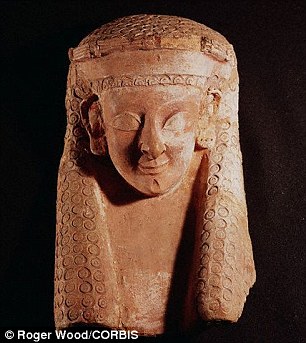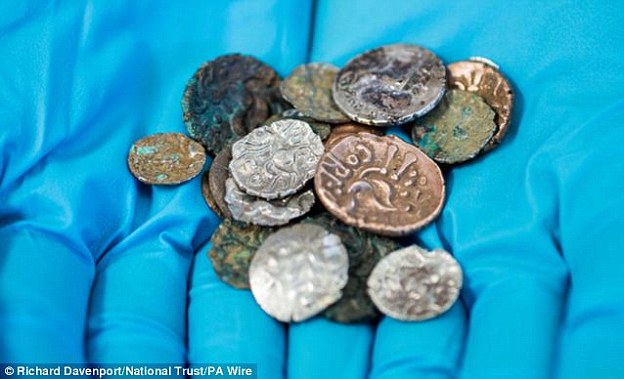It may look like a misshapen disk of metal, but this coin is one of the oldest ever to be found in Britain.
The tiny copper coin, which is smaller than a penny, dates from the Iron Age almost 2,300 years ago and suggests there were links between the south west of England and the Mediterranean.
It was found in silt after the River Avon burst its banks between Bristol and Bath.
On one side there is a horse’s head, while the other bears the image of the goddess Tanit, the chief deity of Carthage.
Experts have dated the coin to between 300 BC and 264 BC and say it came from the Western Mediterranean - probably Sardinia or ancient Carthage.
The find suggests that the village of Saltford, where it was found, was on a major trade route long before Roman times.
Britain's ancient connection to Carthage: 2,300-year-old coin reveals Mediterranean trade route dating back to the Iron Age
Tiny copper coin is dated to the Iron Age, almost 2,300 years ago
It was found in Saltford between Bristol and Bath in South West England
Bears image of a horse's head and the Carthaginian goddess Tanit
Find suggests trading links between South West and the Mediterranean
15 April 2015
Daily Mail
By Sarah Griffiths for MailOnline
It may look like a misshapen disk of metal, but this coin is one of the oldest ever to be found in Britain.
The tiny copper coin, which is smaller than a penny, dates from the Iron Age almost 2,300 years ago and suggests there were links between the south west of England and the Mediterranean.
It was found in silt after the River Avon burst its banks between Bristol and Bath.

The tiny copper coin, which is smaller than a penny, dates from the Iron Age almost 2,300 years ago and suggests there were links between the south west of England and the Mediterranean
On one side there is a horse’s head, while the other bears the image of the goddess Tanit, the chief deity of Carthage.
Experts have dated the coin to between 300 BC and 264 BC and say it came from the Western Mediterranean - probably Sardinia or ancient Carthage.
The find suggests that the village of Saltford, where it was found, was on a major trade route long before Roman times.

On one side of the coin there the image of the Goddess Tanit, the chief deity of Carthage, (pictured left) while on the reverse is a horse’s head, pictured right

The find suggests that the Somerset village of Saltford (shown on the map with a red marker), where the coin was found, was on a major trade route long before Roman times
It is believed there was a ford in the area, which made it the only place to cross the river Avon at the time.

One side of the coin shows an image of the Carthaginian goddess Tanit, suggesting links between the south west and the Mediterranean
The coin is thought to be the oldest dateable evidence of human activity found in Saltford and the West of England.
It suggests Iron Age links between the Mediterranean and the Bristol Channel, which the River Avon flows into around 15 miles (24km) away.
Professor David Mattingly, an archaeologist and Roman historian at the University of Leicester said: ‘It’s really interesting to have a Carthaginian coin in Britain.
‘Suppose that coin was deposited close to its minting - at the time, there were no coins being used in Britain. It would have been quite alien to people.
‘We are very sure that horses were important at the time so that may have invoked a lot of interest back then. It’s a very interesting find.’
Phil Harding of the Saltford Environment Group, said that the coin’s significant because it is one of the oldest coins ever to be found in England.
‘Only eight of these have ever been found, always on ancient trade routes,’ he said.
‘We can’t believe it. We thought we would be writing the history of Saltford from the Roman times to now.
‘But now we have to go back to the Iron Age. It’s absolutely fantastic.’
IRON AGE COIN HOARD FOUND IN A CAVE WITH ROMAN CURRENCY
Last July a hoard of Roman and Late Iron Age coins were found in a cave in Dovedale in the Peak District, where they had lain undisturbed for 2,000 years.
It was the first time that coins from the two separated groups have been found buried together.
Archaeologists discovered 26 coins, including three Roman coins which pre-date the invasion of Britain in 43 AD, and 20 other gold and silver pieces which are Late Iron Age and thought to belong to the Corieltavi tribe.

Last July a hoard of Roman and Late Iron Age coins (pictured) were found in a cave in Dovedale in the Peak District, where they had lain undisturbed for 2,000 years
National Trust archaeologist Rachael Hall said whoever owned the cache was probably a wealthy and influential figure.
'The coins would suggest a serious amount of wealth and power of the individual who owned them.
‘Coins were used more as a symbol of power and status during the Late Iron Age, rather than for buying and selling staple foods and supplies.
‘...The situation of the cave can’t be ignored either. Could it have been a sacred place to the Late Iron Age peoples that was taboo to enter in everyday life, making it a safe place that would ensure that person’s valuables were protected?'
Read more: 2,300-year-old coin reveals Mediterranean trade route dating back to the Iron Age | Daily Mail Online
Follow us: @MailOnline on Twitter | DailyMail on Facebook
The tiny copper coin, which is smaller than a penny, dates from the Iron Age almost 2,300 years ago and suggests there were links between the south west of England and the Mediterranean.
It was found in silt after the River Avon burst its banks between Bristol and Bath.
On one side there is a horse’s head, while the other bears the image of the goddess Tanit, the chief deity of Carthage.
Experts have dated the coin to between 300 BC and 264 BC and say it came from the Western Mediterranean - probably Sardinia or ancient Carthage.
The find suggests that the village of Saltford, where it was found, was on a major trade route long before Roman times.
Britain's ancient connection to Carthage: 2,300-year-old coin reveals Mediterranean trade route dating back to the Iron Age
Tiny copper coin is dated to the Iron Age, almost 2,300 years ago
It was found in Saltford between Bristol and Bath in South West England
Bears image of a horse's head and the Carthaginian goddess Tanit
Find suggests trading links between South West and the Mediterranean
15 April 2015
Daily Mail
By Sarah Griffiths for MailOnline
It may look like a misshapen disk of metal, but this coin is one of the oldest ever to be found in Britain.
The tiny copper coin, which is smaller than a penny, dates from the Iron Age almost 2,300 years ago and suggests there were links between the south west of England and the Mediterranean.
It was found in silt after the River Avon burst its banks between Bristol and Bath.

The tiny copper coin, which is smaller than a penny, dates from the Iron Age almost 2,300 years ago and suggests there were links between the south west of England and the Mediterranean
On one side there is a horse’s head, while the other bears the image of the goddess Tanit, the chief deity of Carthage.
Experts have dated the coin to between 300 BC and 264 BC and say it came from the Western Mediterranean - probably Sardinia or ancient Carthage.
The find suggests that the village of Saltford, where it was found, was on a major trade route long before Roman times.

On one side of the coin there the image of the Goddess Tanit, the chief deity of Carthage, (pictured left) while on the reverse is a horse’s head, pictured right

The find suggests that the Somerset village of Saltford (shown on the map with a red marker), where the coin was found, was on a major trade route long before Roman times
It is believed there was a ford in the area, which made it the only place to cross the river Avon at the time.

One side of the coin shows an image of the Carthaginian goddess Tanit, suggesting links between the south west and the Mediterranean
The coin is thought to be the oldest dateable evidence of human activity found in Saltford and the West of England.
It suggests Iron Age links between the Mediterranean and the Bristol Channel, which the River Avon flows into around 15 miles (24km) away.
Professor David Mattingly, an archaeologist and Roman historian at the University of Leicester said: ‘It’s really interesting to have a Carthaginian coin in Britain.
‘Suppose that coin was deposited close to its minting - at the time, there were no coins being used in Britain. It would have been quite alien to people.
‘We are very sure that horses were important at the time so that may have invoked a lot of interest back then. It’s a very interesting find.’
Phil Harding of the Saltford Environment Group, said that the coin’s significant because it is one of the oldest coins ever to be found in England.
‘Only eight of these have ever been found, always on ancient trade routes,’ he said.
‘We can’t believe it. We thought we would be writing the history of Saltford from the Roman times to now.
‘But now we have to go back to the Iron Age. It’s absolutely fantastic.’
IRON AGE COIN HOARD FOUND IN A CAVE WITH ROMAN CURRENCY
Last July a hoard of Roman and Late Iron Age coins were found in a cave in Dovedale in the Peak District, where they had lain undisturbed for 2,000 years.
It was the first time that coins from the two separated groups have been found buried together.
Archaeologists discovered 26 coins, including three Roman coins which pre-date the invasion of Britain in 43 AD, and 20 other gold and silver pieces which are Late Iron Age and thought to belong to the Corieltavi tribe.

Last July a hoard of Roman and Late Iron Age coins (pictured) were found in a cave in Dovedale in the Peak District, where they had lain undisturbed for 2,000 years
National Trust archaeologist Rachael Hall said whoever owned the cache was probably a wealthy and influential figure.
'The coins would suggest a serious amount of wealth and power of the individual who owned them.
‘Coins were used more as a symbol of power and status during the Late Iron Age, rather than for buying and selling staple foods and supplies.
‘...The situation of the cave can’t be ignored either. Could it have been a sacred place to the Late Iron Age peoples that was taboo to enter in everyday life, making it a safe place that would ensure that person’s valuables were protected?'
Read more: 2,300-year-old coin reveals Mediterranean trade route dating back to the Iron Age | Daily Mail Online
Follow us: @MailOnline on Twitter | DailyMail on Facebook
Last edited: